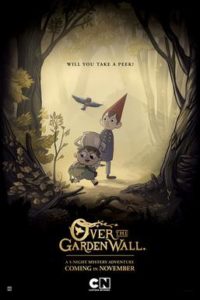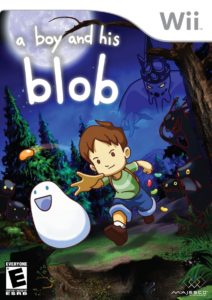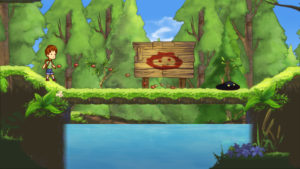A month or two ago, I was introduced to a cartoon with which I fell instantly in love. The title, as you no doubt surmise from the title of this blog entry, is Over the Garden Wall. It’s a 10-episode series with each episode lasting 11 minutes, leading to a total run time of a little under two hours.
Now, I have a cousin–an aspiring moviemaker–who intends to make a movie inspired by Over the Garden Wall, and he asked me a few weeks ago to send him an email wherein I detailed my thoughts about what makes the series so great. As I have thus far been remiss in this duty to my esteemed relative and I flatter myself to believe that my thoughts on the matter may be of interest to a slightly wider audience (not deluding myself as to the readership numbers of this blog), I have decided to put forth my thoughts in this larger forum.

First let me give a brief background for those who have not had the pleasure of seeing this animated masterpiece. Over the Garden Wall is the story of two brothers, Wirt–a studious, geeky, awkward high schooler– and Greg–a strange, whimsical young child of about six or seven–who have found themselves lost in a magical forest from which they are trying to find their way home. On their way, they encounter many interesting and peculiar characters, some of which assist them in their quest, and some of which hinder them. The basic story idea is nothing new, but it’s a solid premise.
And now that I’ve given that brief introduction, I am faced with the challenge of explaining exactly what’s great about Over the Garden Wall. I’ve sat here for about ten minutes now trying to decide how to proceed, and no clear way has presented itself. So what I’m going to do is describe some of the individual elements that make the show stand out, and hopefully by the end a schema for fitting them all together will show up.
First, I love the animation. I think what I like most about it is the way that it blends styles. For the most part, the characters are animated in what I would characterize as a very modern American animation style, not out of the ordinary for what one would see on Cartoon Network. It’s not a style I’m actually particularly fond of, but it’s done well, and clearly a lot of polishing has been done. Meanwhile, the scenery is beautiful and evokes (to me at least) a German Black Forest vibe. Those are the two main art styles, but there were also some times (particularly in an episode that takes place entirely within a dream) where the art seems to be imitating a much older style of American animation, akin to a colorized Betty Boop or Popeye. And non-talking animals tend to be rendered much more realistically than the human characters. There’s an episode that involves non-anthropomorphic animals that have been dressed up in human clothes, and the effect created by a non-anthropomorphic Opossum wearing overalls sitting next to Greg is both hilarious and disconcerting.
And then there’s the wonderful attention to detail. If the camera is following Wirt, you will always be able to catch glimpses of what Greg is doing in the background, which is usually funny and often winds up being plot-relevant. There’s also an episode where Greg steps in a pumpkin and spends half of the next episode walking around with a weird gait because of the pumpkin still stuck on his foot. The show is full of things like that–little things that show the care the animators took.
Next let me talk about the music. Music plays an important part in Over the Garden Wall. Many of the characters sing, and the songs that they sing provide characterization. Greg, in particular, sings a lot, largely songs of his own devising. The brilliance in Greg’s songs lies in both their eccentric humor and in their low quality. What I mean by that is that the songs, while often catchy and very funny have the sort of odd free association that occurs in songs by real children. Consider the following lines:
Oh potatoes and molasses,
If you want some, Oh just ask us!
They’re warm and soft like puppies and socks
Filled with cream and candy rocks!
These lines, while undeniably funny make only slightly more sense than songs that I have heard real little children make up, which is brilliant on the part of whomever is responsible. The creators managed to make a song that simultaneously sounds like it was written by a child and is something you might actually want to listen to.
Wirt, unfortunately, rarely sings. We see an instance where he tries, but he clearly either never had the skill of whimsical song-weaving or has lost it. His awkward attempt at an off-the-cuff song doesn’t rhyme or scan and misses more notes than it hits. We do learn, though, that he plays the clarinet, and in the one instance where we here him play the bassoon, he does a good job.
Which brings me to characterization. One of the areas where Over the Garden Wall really shines is in its characters. The story specifically focuses, of course, on the two brothers (indeed, I would argue that the main theme of the series is brotherhood–particularly what it means to be an older brother). Hopefully, by now you’ve gotten some idea of what Greg and Wirt are like. Looking at the musical examples we can see some aspects of each of their character. Greg is free-spirited, innocent, and a little strange. Wirt is considerably more constrained and he’s the type of person who plays the clarinet. The incredible thing is that in almost every scene, the creators take an opportunity to cram some characterization in, whether that characterization be Wirt going on about how his life is like “a boat upon a winding river, twisting toward an endless black sea” blah blah blah or Greg coming up with a new name for his frog.
There are also some wonderful side characters. There’s Beatrice, a bluebird who seems to only grudgingly accept her role as the brothers’ guide. There’s the eccentric old tea baron who isn’t sure whether he’s more afraid of the idea that he’s seen a ghost or the idea that he’s going crazy. And there’s the frog, who starts off being named Kitty and winds up being named… but that would spoil it.
I also love the world that has been created. It reminds me of Oz: a series of strange communities with little tying them together, each of which has odd quirks. The second episode features a strange community that uses giant turkeys as draft animals. Another episode has a tavern full of people defined by their professions, each of whom is happy to sing a song about it (including the highwayman).
Which brings me back to the difficulty of bringing this all together. Because what makes this really work is that all of these elements–character, setting, music, art–tie together into a cohesive whole. They all build on each other to create a series with a very definite tone. I would call this union “voice”, but I think it encompasses much more than that. I would call it “world building”, but once again, I think it encompasses more. I am tempted to call it “aesthetic”, but that may give the impression that the whole thing is superficial, when it’s clearly more. Perhaps the word I’m looking for is gestalt, but as I haven’t read extensively about just what “gestalt” is, I’m worried that’s all wrong.
At any rate, the show is good. I’ve heard that sometimes talking things up too much makes people less inclined to look at them, so instead I’ll follow up this gushing praise with “It’s okay, I guess” or maybe “You could give it a watch if you like, but you don’t have to”.
And if anyone can tell me what word I want, please do so.

